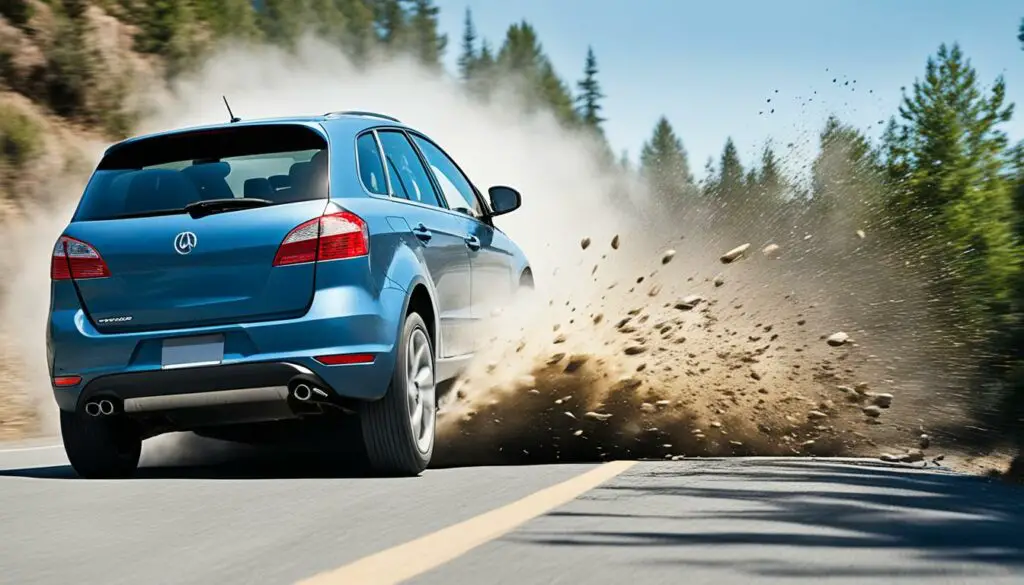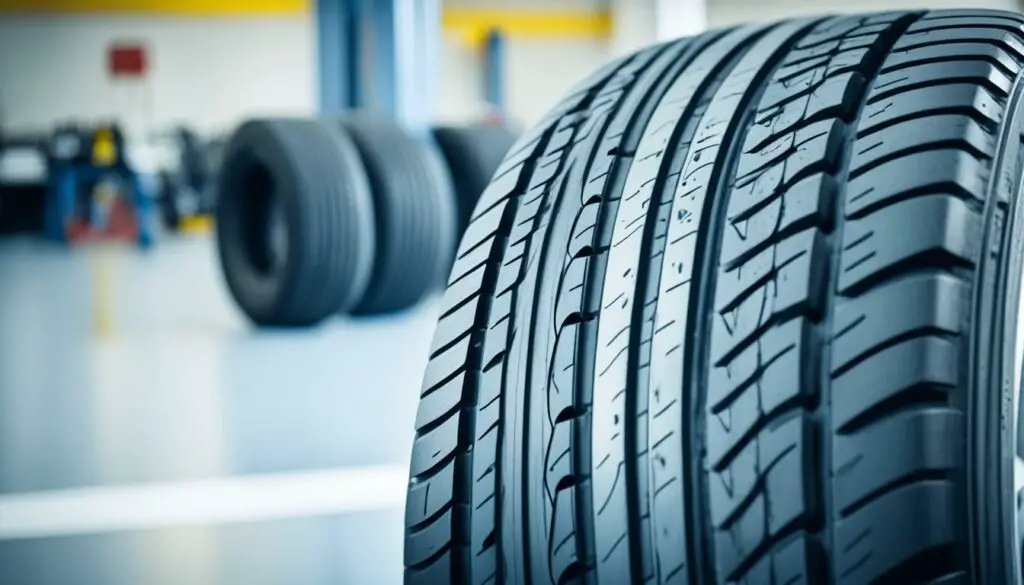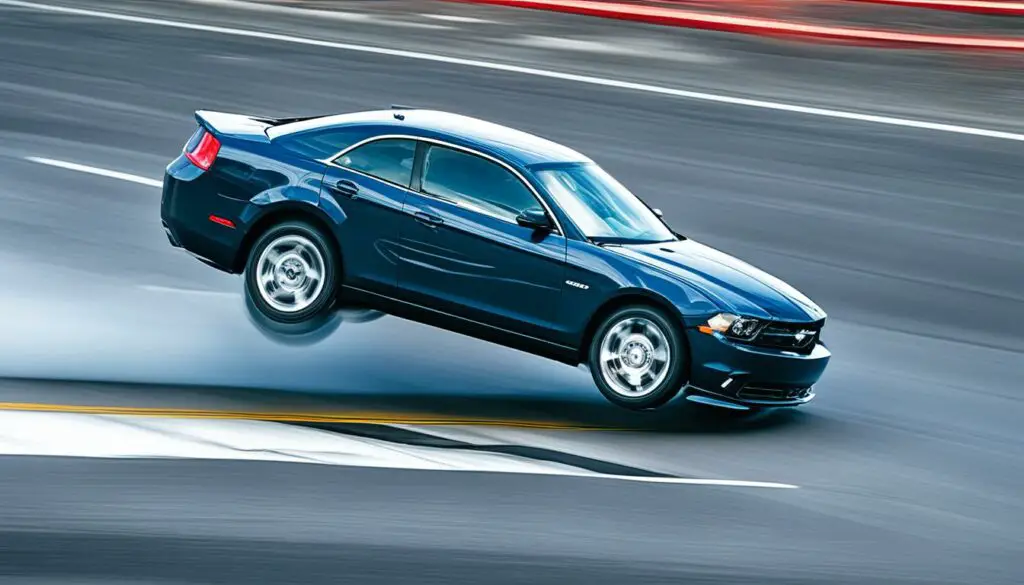Is your steering wheel shaking uncontrollably? Don’t ignore it! This might be “death wobble,” a serious issue. But can unbalanced tires cause death wobble? Dive in to find out and ensure a safer ride.
Ever driven down the road and felt your steering wheel vibrate uncontrollably? That could be a sign of unbalanced tires. But did you know unbalanced tires can also contribute to death wobble, a terrifying situation where your entire vehicle violently shakes?
Yes, unbalanced tires can contribute to death wobble, but they are not the main cause. Unbalanced tires create vibrations that strain suspension components, which can worsen existing death wobble conditions or make them more likely to occur.

So, what exactly is death wobble? It’s a severe shaking of the front end of your vehicle, often caused by worn-out suspension and steering components. While unbalanced tires won’t directly cause death wobble, the vibrations they create can put additional stress on these components, accelerating wear and tear and increasing the risk of death wobble.
Thinking about skipping tire rotations and balancing? In this guide, we will delve deeper into the causes of death wobble, how unbalanced tires play a role, and why regular maintenance is crucial for a safe and smooth ride. Stay tuned!
Key Takeaways:
- Unbalanced tires can contribute to the occurrence of death wobble, a violent shaking of the vehicle’s front end.
- Tire imbalance creates vibrations that strain the suspension and steering components.
- Regular maintenance, including tire balancing, is necessary to prevent death wobble and ensure optimal vehicle stability.
- Addressing tire imbalance helps reduce the risk of loosened bolts and worn out parts.
- Proactive measures such as proper tire maintenance can significantly reduce the likelihood of experiencing death wobble caused by unbalanced tires.
What is Death Wobble and How It Occurs?
Death wobble is a terrifying experience for drivers. It’s a violent shaking of the steering wheel, often accompanied by vibrations throughout the entire vehicle. This shaking can be so severe that it’s difficult, or even impossible, to control the car.
Death wobble is a violent shaking of the steering wheel in a car, typically caused by a combination of worn-out suspension components and looseness in the steering system. It can be dangerous and difficult to control the vehicle.
Death wobble typically occurs at higher speeds, often triggered by hitting a bump or pothole. It’s most common in vehicles with solid front axles, like Jeeps, trucks, and some SUVs.
So, what causes this scary phenomenon?
Several factors can contribute to death wobble, but it usually boils down to excessive looseness in the steering and suspension systems. This looseness can be caused by worn-out components, such as tie rods, track bars, or control arm bushings. In some cases, modifications like lifted suspensions or larger tires can also increase the risk of death wobble.
If you ever experience death wobble, the most important thing is to stay calm and gradually slow down until the shaking subsides. Do not slam on the brakes, as this can worsen the situation. Once you’ve regained control, pull over to a safe location and have your vehicle inspected by a qualified mechanic as soon as possible.
Distinguishing Between Normal Vehicle Vibrations and Death Wobble
It is important to distinguish between normal vehicle vibrations and the symptoms of death wobble to identify and address the issue effectively. Normal vehicle vibrations can be caused by factors such as road conditions, tire tread pattern, or tire pressure. These vibrations are typically mild and do not pose a significant risk to vehicle stability.
On the other hand, death wobble is characterized by its violent shaking and instability, often occurring at higher speeds or after hitting a bump. It is important not to ignore these symptoms and address them promptly to prevent any potential safety risks.
Distinguishing between normal vehicle vibrations and death wobble requires careful observation and analysis of the vehicle’s behavior. If the shaking is severe, uncontrollable, and accompanied by steering wheel oscillation, it is likely a case of death wobble.
You might also like: Do Trailer Tires Need to Be Balanced? Expert Advice Revealed
What Causes the Death Wobble in a Vehicle?
The term “death wobble” strikes fear into the hearts of drivers, and for good reason. This violent shaking of the steering wheel and entire vehicle can be terrifying and potentially dangerous. But what exactly causes this phenomenon? Let’s delve into the culprits behind the chaos:
Worn or Loose Steering and Suspension Components
This is the main culprit behind death wobble. Parts like ball joints, tie rod ends, track bars, and wheel bearings all play crucial roles in maintaining precise control over your vehicle’s direction.
When these components become worn, loose, or damaged, they create unwanted play in the system. This play, when triggered by bumps or uneven terrain, can initiate a domino effect, rapidly amplifying small movements into violent shaking.
Unbalanced Tires
While not the main cause, unbalanced tires can certainly contribute to death wobble. When the weight distribution around a tire’s circumference is uneven, it creates an imbalance that can cause a wobbling sensation at higher speeds. This wobble, if coupled with other pre-existing issues in the steering or suspension, can escalate into a full-blown death wobble event.
Incorrectly Installed Lift Kits
Modifying your vehicle’s suspension, particularly adding a lift kit, can introduce new elements that, if not installed or calibrated correctly, can lead to death wobble. Improper installation can alter the vehicle’s geometry, affecting steering and suspension dynamics.
Additionally, lifting the vehicle without adjusting other components like the track bar can introduce unwanted play, creating the perfect breeding ground for death wobble.
Misaligned Wheels
Proper wheel alignment is crucial for maintaining optimal handling and tire wear. However, when wheels are misaligned, it can cause them to pull in different directions, creating a tug-of-war effect on the steering system. This constant strain, especially when combined with other contributing factors, can increase the risk of death wobble.
Worn Shocks and Struts
Shocks and struts are responsible for dampening road imperfections and keeping your tires planted firmly on the ground. When they wear out, their ability to control the vehicle’s movement diminishes. This lack of control, coupled with other underlying issues, can contribute to the onset of death wobble.

You must know, death wobble is rarely caused by a single factor. It’s often a combination of these issues that creates the perfect storm. Regular maintenance, proper installation of modifications, and addressing any signs of wear and tear in these crucial components are key to preventing the dreaded death wobble and ensuring a safe and smooth ride.
Factors Contributing to Death Wobble in Vehicles
The term “death wobble” perfectly describes the violent and potentially dangerous shaking of a vehicle’s steering wheel and overall frame. It’s a phenomenon that can have several causes. Let’s explore the main contributors:
| Contributing Factors | Description |
|---|---|
| Worn/Loose Steering and Suspension Parts | Creates play in steering, amplifying into violent shaking. |
| Unbalanced Tires | Causes wobbling at high speeds, can worsen death wobble. |
| Incorrectly Installed Lift Kits | Alters vehicle geometry, increasing death wobble risk. |
| Misaligned Wheels | Leads to steering strain and potential contribution to death wobble. |
| Worn Shocks and Struts | Loss of motion control, making vehicle prone to death wobble. |
You might also like: Is Wheel Balancing Necessary for New Tires? Busting Myths
Can Unbalanced Tires Cause Death Wobble?
Death wobble is a terrifying experience for any driver. It’s characterized by violent shaking of the steering wheel and entire vehicle, often triggered by hitting a bump at speed. While unbalanced tires aren’t the main cause of death wobble, they can contribute to the problem.
So, can unbalanced tires cause death wobble?
Yes, unbalanced tires can contribute to death wobble by putting stress on worn suspension components. However, they are not the main cause. Worn steering parts, improper modifications, and defective components are more likely culprits.
Here’s why:
- Uneven weight distribution: When a tire is unbalanced, it creates a force that tries to pull it up and down as it spins. This can put extra stress on suspension components, potentially causing them to wear out faster.
- Vibrations: Unbalanced tires also vibrate excessively, which can further loosen worn components and trigger death wobble if other underlying issues are present.
However, it’s crucial to remember that unbalanced tires are just one piece of the puzzle. The main causes of death wobble typically lie in worn-out or damaged suspension components like:
- Track bar
- Steering damper
- Ball joints
- Control arm bushings
Unbalanced tires can exacerbate existing death wobble issues. The uneven weight distribution in an unbalanced tire creates a rhythmic shaking, putting stress on the steering and suspension components. Over time, this stress can loosen bolts and exacerbate worn parts, increasing the likelihood of death wobble occurring.
Unbalanced tires can have significant effects on the overall stability and safety of a vehicle. These effects include:
- Increased vibration: Unbalanced tires create vibrations that can cause discomfort and affect the smoothness of the ride.
- Reduced handling and control: The vibrations from unbalanced tires can make it more challenging to steer and control the vehicle effectively.
- Uneven tire wear: Tire imbalance can cause uneven wear on the tires, leading to reduced traction and handling performance.
- Premature tire wear and damage: Unbalanced tires place extra stress on specific areas of the tire, leading to premature wear and potential damage.
- Decreased fuel efficiency: The additional strain caused by tire imbalance can result in increased rolling resistance, leading to lower fuel efficiency.
If you’re experiencing death wobble, it’s essential to have a qualified mechanic diagnose the issue and address the root cause, not just focus solely on tire balancing. You must understand, preventative maintenance is key. Regularly inspect your suspension components and address any wear and tear promptly to avoid the potential dangers of death wobble.
Unbalanced Tire Effects and Vehicle Safety Concerns
Imagine driving down the road, but instead of a smooth ride, your car feels like it’s trembling. This isn’t just an annoyance; it’s a sign of unbalanced tires, a common problem with significant safety and financial implications. Unbalanced tires occur when the weight distribution across the tire and wheel assembly is uneven. This can cause:
- Dangerous vibrations: The uneven weight creates a shaking sensation, making it harder to control your vehicle, especially at higher speeds. This can lead to accidents and loss of vehicle control.
- Reduced tire life: Uneven wear and tear on the tire due to the weight imbalance significantly shortens its lifespan, requiring more frequent replacements and increasing your overall tire costs.
- Increased fuel consumption: The vibrations caused by unbalanced tires create additional resistance, forcing the engine to work harder and burn more fuel to maintain speed. This puts a strain on your wallet and the environment.
- Uneven tire wear: As unbalanced tires wear unevenly, certain areas lose grip and stability, compromising traction, particularly in wet or icy conditions, where maintaining control is crucial. This can lead to increased stopping distances and potential accidents.

Regular tire balancing is a simple and affordable solution to address these issues and ensure optimal vehicle safety and performance. By routinely balancing your tires, you can:
- Minimize the risk of dangerous vibrations for a smoother and safer driving experience.
- Maintain proper tire wear to extend tire life and save money on replacements.
- Enhance fuel efficiency by reducing engine strain and lowering fuel costs.
- Promote overall safety by ensuring optimal tire performance in all driving conditions.
Don’t ignore the telltale signs of unbalanced tires: vibrations, uneven wear, and decreased fuel economy. Schedule regular tire balancing as part of your routine car maintenance to ensure a safe and enjoyable driving experience.
Must check: What Causes Tires to Wear on the Inside? Expert Insights
The Dynamics of Tire Imbalance and Oscillations in Steering
When tires are not equally weighted, they cause unbalanced tires. This imbalance disrupts the uniform rotation of the tires, leading to vibrations. At higher speeds, these vibrations magnify, causing the steering wheel shake.
This phenomenon is not just uncomfortable but can signal potential safety risks. Addressing this imbalance early prevents the escalation of vibrations, ensuring a smoother and safer driving experience, especially at highway speeds.
How Unbalanced Tires Trigger Oscillation in the Front Axle
When tires are unbalanced, they fail to distribute weight evenly, leading to significant oscillations in the front axle. This imbalance causes the wheel assembly to rotate unevenly, especially noticeable at higher speeds. The inconsistency in rotation generates a centrifugal force, pushing the wheel outward and creating a wobble.
This wobble translates into the steering mechanism, resulting in a noticeable steering wheel shake at highway speeds. The vibration is felt directly through the steering column, alerting drivers to the imbalance.
Immediate effects include reduced driving comfort and increased fatigue over long distances. Moreover, the continuous vibration strains the steering components, potentially leading to premature wear.

Regular tire maintenance and balancing are crucial to prevent these oscillations, ensuring a smoother ride and prolonged vehicle lifespan.
Consequences of Neglecting Tire Balancing on Steering Performance
Neglecting tire balancing has dire consequences on steering performance. Initially, the minor imbalance may seem inconsequential, but over time, the continuous vibrations exert undue stress on steering components. This stress leads to accelerated wear and tear of steering rack and suspension systems.
Furthermore, the persistent vibrations compromise the steering precision, making it challenging to maintain straight-line stability. This degradation in steering response increases the risk of driver fatigue, as more effort is required to control the vehicle, especially at high speeds.
The cumulative effect of these issues not only diminishes the driving experience but also poses significant safety risks. Ensuring regular tire balancing is pivotal for maintaining optimal steering performance, enhancing vehicle safety, and ultimately, protecting driver and passenger well-being on the road.
| Consequences of Neglecting Tire Balancing: | Potential Effects on Steering Performance: |
|---|---|
| Uneven tire wear | Decreased steering responsiveness |
| Increased vibrations | Reduced stability |
| Premature wear of suspension and steering components | Compromised steering control |
| Loosening of bolts | Heightened risk of death wobble |
Regular tire balancing is essential for maintaining optimal steering performance and preventing the dangerous effects of unbalanced tires. By addressing tire imbalance through routine maintenance, drivers can ensure a smoother, more stable driving experience and reduce the risk of oscillations, steering instability, and potentially, death wobble.
You might also like: How to Balance Tires at Home Without Equipment: DIY Guide
Can Tires Cause Death Wobble: Investigating Contributing Factors
Tires play a crucial role in the occurrence of death wobble. Certain tire conditions can increase the risk of experiencing this dangerous phenomenon. Understanding these conditions and implementing preventive measures is essential for avoiding death wobble triggers and ensuring safe driving.
Tire Conditions That May Lead to Death Wobble
Several tire conditions can contribute to the occurrence of death wobble. These include:
- Significant tire imbalance: When tires are significantly unbalanced, it can create vibrations that strain the suspension and steering components, potentially leading to death wobble. Regular tire balancing is necessary to avoid this imbalance.
- Uneven tire wear: Uneven wear patterns on the tires can disrupt the smooth rotation, causing instability and increasing the risk of death wobble. Regular tire rotation and alignment checks help to prevent this issue.
- Damaged sidewalls: Tires with damaged or weakened sidewalls may not provide adequate support, leading to instability in the vehicle’s front end. Inspecting tires for sidewall damage regularly is crucial.
By addressing these tire conditions, drivers can significantly reduce the likelihood of experiencing death wobble caused by unbalanced tires and other tire-related issues.
Preventive Measures to Avoid Death Wobble Triggers
To prevent death wobble triggered by tire issues, it is important to take the following preventive measures:
- Regular tire maintenance: Performing regular tire maintenance, including balancing, alignment checks, and proper inflation, helps to identify and address tire-related issues before they lead to death wobble. Following manufacturer-recommended intervals is essential for maintaining optimal tire performance.
- Professional inspections: Visiting a trusted automotive professional for regular inspections can ensure that tires are in good condition and properly balanced. Professionals have the expertise and tools to diagnose and rectify tire-related issues effectively.
- Proper tire selection: Choosing tires suitable for the vehicle and driving conditions can help prevent death wobble caused by tire instability. Considering factors such as load capacity, tread pattern, and size is crucial for optimal vehicle performance.
By implementing these preventive measures, drivers can minimize the risk of death wobble and promote safer driving experiences.
Must check: What Causes Tire Cupping and How Can it Be Prevented?
Preventing Death Wobble with Balanced Tires and Regular Maintenance
Death wobble – the name alone sends shivers down the spine of any driver. This violent shaking in the front end can be terrifying and dangerous. While various factors contribute to death wobble, proper tire maintenance plays a crucial role in prevention.
Balanced Tires, Balanced Ride:
The key lies in even weight distribution. Tire balancing ensures your tires and wheels are perfectly balanced, minimizing vibrations that can stress your suspension and steering components. Unbalanced tires act like wobbly wobblers, causing vibrations that can trigger the dreaded death wobble.
Beyond Balancing:
Regular tire maintenance goes beyond just balancing. Here’s the three-pronged approach for a smooth and safe journey:
- Alignment checks: Ensure your wheels are properly aligned to reduce stress on the suspension and steering system, preventing unnecessary wear and tear.
- Tire rotation: Rotate your tires regularly to promote even tread wear, maintaining optimal traction and stability. Uneven wear can throw off your vehicle’s balance and contribute to death wobble.
- Proper inflation: Always inflate your tires to the manufacturer’s recommended pressure. This not only improves fuel efficiency but also enhances overall performance and safety. Underinflated tires can cause handling issues and increase the risk of death wobble.
Prevention is Key:
Prioritizing tire maintenance is an investment in your safety. By following the recommended intervals for balancing (every 6,000-10,000 miles), alignment checks, and tire rotation, you significantly reduce the risk of death wobble and ensure a smooth, stable driving experience.
You must remember; a little effort in maintaining your tires can go a long way in preventing a big problem. Keep your family and yourself safe on the road by making regular tire maintenance a priority.
Must check: Why Do New Car Tires Wear Out So Fast? An Expert’s Take
Addressing Death Wobble: Professional Repair and DIY Solutions
When it comes to addressing death wobble caused by unbalanced tires, there are both professional repair options and DIY solutions available. The choice between the two depends on the severity of the issue, your level of technical expertise, the availability of equipment, and the cost associated with fixing death wobble.
Professional Interventions to Rectify Unbalanced Tires
Professional interventions for rectifying unbalanced tires involve diagnosing and correcting tire imbalance using specialized equipment and techniques. A professional technician will typically perform the following steps:
- Tire Inspection: The technician assesses the condition of the tires, looking for signs of imbalance, uneven wear, or damage.
- Wheel Balancing: Using a balancing machine, the technician identifies the areas of imbalance and adds or removes weights to achieve a properly balanced tire.
- Alignment Check: The technician checks the alignment of the wheels to ensure they are properly aligned with each other and the vehicle’s specifications.
- Suspension Evaluation: The technician examines the suspension components, such as the front track bar and ball joints, to identify any potential issues contributing to death wobble.
- Additional Repairs: If necessary, the technician may recommend or perform repairs on worn or damaged suspension and steering components that may be exacerbating the death wobble.
Professional interventions offer the advantage of specialized expertise and access to professional-grade equipment. They can ensure thorough diagnostics and effective rectification of unbalanced tires to mitigate the risk of death wobble.
DIY Approaches to Tire Balancing and Reducing Death Wobble Risks
For those inclined towards DIY solutions or looking to reduce costs, there are various approaches to tire balancing that can help reduce death wobble risks. Some DIY techniques include:
- Manual Balancing: This involves manually adding or removing small weights on the wheel to achieve balance. While it can be time-consuming and requires precision, it can be an effective DIY method for reducing tire imbalance.
- Portable Balancing Systems: Portable tire balancing systems allow DIYers to achieve balance by attaching small balancing weights to the wheel. These systems can be convenient and easy to use, providing a practical solution for DIY tire balancing.
- Tire Rotation: Regularly rotating the tires can help distribute any imbalance and even out wear patterns, reducing the risk of death wobble caused by unbalanced tires.
DIY approaches to tire balancing require careful attention to detail and adherence to proper techniques. While they may not offer the same level of expertise as professional interventions, they can be a cost-effective solution for addressing minor tire imbalances and reducing the risk of death wobble.
Comparison of Professional Interventions and DIY Approaches for Addressing Death Wobble:
| Criteria | Professional Interventions | DIY Approaches |
|---|---|---|
| Level of Expertise | Highly skilled technicians | DIY enthusiasts |
| Equipment Needed | Specialized tools and machinery | Basic tools and portable balancing systems |
| Cost | Higher | Lower (potential savings on labor costs) |
| Accuracy | Precise diagnostics and correction | Manual precision required |
| Additional Repairs | Can address underlying suspension issues | Limited to tire balancing |
Ultimately, whether you choose professional repair or a DIY approach to addressing death wobble caused by unbalanced tires depends on your personal circumstances and preferences. Both options can be effective in reducing the risk of death wobble and ensuring safer driving experiences.
Ensuring Stability: Can Unbalanced Tires Cause Death Wobble?
To prevent death wobble and ensure safe driving, understanding the role of tire care is crucial. Can unbalanced tires cause death wobble? Absolutely. While unbalanced tires are not the sole perpetrators, they lay the groundwork for this frightening phenomenon. By inducing undue stress on suspension and steering components, they can spark the conditions leading to a death wobble.
Yes, unbalanced tires can cause death wobble by creating vibrations that stress suspension and steering components, leading to potential instability. Regular maintenance, including tire balancing, alignment checks, and proper inflation, can significantly reduce this risk.
However, it’s essential to note that unbalanced tires are not the main cause of death wobble. Various factors contribute, but neglecting tire balance and alignment certainly heightens the risk. To sidestep this hazard, how to prevent death wobble becomes a pertinent question. Regular tire maintenance – balancing every 6,000 to 10,000 miles, alignment checks, and proper inflation – are your best defenses.
In simple words, tire care is not just about preventing death wobble; it’s about safeguarding your journey. Adopt these practices to enjoy smoother rides, extended tire life, and enhanced safety. Remember, regular maintenance is the key to keeping the shakes at bay.
You’ll likely appreciate diving into: